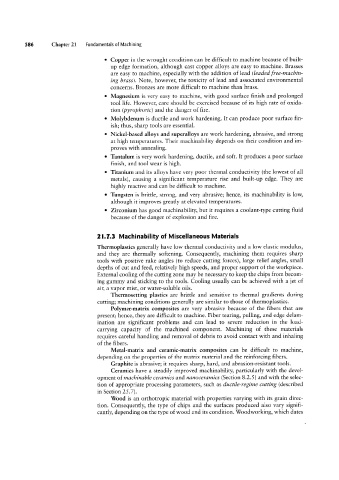Page 605 - 04. Subyek Engineering Materials - Manufacturing, Engineering and Technology SI 6th Edition - Serope Kalpakjian, Stephen Schmid (2009)
P. 605
8 Chapter 21 Fundamentals of Machining
° Copper in the wrought condition can be difficult to machine because of built-
up edge formation, although cast copper alloys are easy to machine. Brasses
are easy to machine, especially with the addition of lead (leaded free-machiw
ing brass). Note, however, the toxicity of lead and associated environmental
concerns. Bronzes are more difficult to machine than brass.
° Magnesium is very easy to machine, with good surface finish and prolonged
tool life. However, care should be exercised because of its high rate of oxida-
tion (pyrophoric) and the danger of fire.
° Molybdenum is ductile and work hardening. It can produce poor surface fin-
ish; thus, sharp tools are essential.
° Nickel-based alloys and superalloys are work hardening, abrasive, and strong
at high temperatures. Their machinability depends on their condition and im-
proves with annealing.
° Tantalum is very work hardening, ductile, and soft. It produces a poor surface
finish, and tool wear is high.
° Titanium and its alloys have very poor thermal conductivity (the lowest of all
metals), causing a significant temperature rise and built-up edge. They are
highly reactive and can be difficult to machine.
° Tungsten is brittle, strong, and very abrasive; hence, its machinability is low,
although it improves greatly at elevated temperatures.
° Zirconium has good machinability, but it requires a coolant-type cutting fluid
because of the danger of explosion and fire.
2I.7.3 Machinability of Miscellaneous Materials
Thermoplastics generally have low thermal conductivity and a low elastic modulus,
and they are thermally softening. Consequently, machining them requires sharp
tools with positive rake angles (to reduce cutting forces), large relief angles, small
depths of cut and feed, relatively high speeds, and proper support of the workpiece.
External cooling of the cutting zone may be necessary to keep the chips from becom-
ing gummy and sticking to the tools. Cooling usually can be achieved with a jet of
air, a vapor mist, or water-soluble oils.
Thermosetting plastics are brittle and sensitive to thermal gradients during
cutting; machining conditions generally are similar to those of thermoplastics.
Polymer-matrix composites are very abrasive because of the fibers that are
present; hence, they are difficult to machine. Fiber tearing, pulling, and edge delam-
ination are significant problems and can lead to severe reduction in the load-
carrying capacity of the machined component. Machining of these materials
requires careful handling and removal of debris to avoid contact with and inhaling
of the fibers.
Metal-matrix and ceramic-matrix composites can be difficult to machine,
depending on the properties of the matrix material and the reinforcing fibers.
Graphite is abrasive; it requires sharp, hard, and abrasion-resistant tools.
Ceramics have a steadily improved machinability, particularly with the devel-
opment of machinable ceramics and nanoceramics (Section 8.2.5 ) and with the selec-
tion of appropriate processing parameters, such as ductile-regime cutting (described
in Section 25.7).
Wood is an orthotropic material with properties varying with its grain direc-
tion. Consequently, the type of chips and the surfaces produced also vary signifi-
cantly, depending on the type of wood and its condition. Woodworking, which dates

